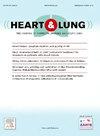The genetic support for the causal relationship between 91 circulating inflammatory proteins and pneumothorax: A two-sample mendelian randomization study
IF 2.6
4区 医学
Q2 CARDIAC & CARDIOVASCULAR SYSTEMS
引用次数: 0
Abstract
Background
Pneumothorax, a common pleural disease, has an unclear pathogenesis. Observational studies suggest that inflammation may directly or indirectly contribute to the development of pneumothorax.
Objectives
To investigate the causal relationship between circulating inflammatory proteins and pneumothorax using Mendelian randomization (MR) analysis.
Methods
We conducted a two-sample Mendelian randomization (MR) analysis by combining genome-wide association study (GWAS) data on 91 circulating inflammatory proteins with pneumothorax GWAS data. Five MR methods were applied: Inverse Variance Weighted (IVW), MR-Egger, Weighted Median, Weighted Mode, and Simple Mode. Directionality was assessed using the MR Steiger test. Sensitivity analyses included Cochran’ s Q test, the MR-PRESSO global test, the MR-Egger regression intercept test, and a leave-one-out analysis. To further mitigate confounding, multivariable MR analyses were conducted using GWAS data on biological and phenotypic age as covariates.
Results
Four inflammatory proteins were causally associated with pneumothorax. Protective proteins included Interleukin-17A (IL-17A) [OR = 0.83, 95 % CI (0.69, 0.99), p = 0.04] and SIR2-like protein 2 (SIRT2) [OR = 0.72, 95 % CI (0.57, 0.93), p = 0.01]. Risk-associated proteins included Interleukin-13 (IL-13) [OR = 1.23, 95 % CI (1.03, 1.47), p = 0.02] and TNF-related apoptosis-inducing ligand (TRAIL) [OR = 1.22, 95 % CI (1.02, 1.44), p = 0.02]. Multivariable MR confirmed the robustness of the associations, particularly for IL-13. Sensitivity analyses revealed no substantial pleiotropy or heterogeneity.
Conclusions
The results yield novel perspectives on the etiological association between systemic inflammatory mediators and pneumothorax pathogenesis, potentially identifying candidate biomarkers for risk stratification and therapeutic targeting in pneumothorax management.
91种循环炎症蛋白与气胸因果关系的遗传支持:一项双样本孟德尔随机化研究
背景:气胸是一种常见的胸膜疾病,其发病机制尚不清楚。观察性研究表明,炎症可能直接或间接地促进气胸的发展。目的应用孟德尔随机化(MR)分析探讨循环炎症蛋白与气胸的因果关系。方法将91种循环炎症蛋白的全基因组关联研究(GWAS)数据与气胸的全基因组关联研究(GWAS)数据相结合,进行双样本孟德尔随机化(MR)分析。采用了五种MR方法:方差加权逆法(IVW)、MR- egger法、加权中位数法、加权模式法和简单模式法。使用MR Steiger测试评估方向性。敏感性分析包括科克伦Q检验、MR-PRESSO全局检验、MR-Egger回归截距检验和留一分析。为了进一步减少混淆,使用GWAS数据对生物和表型年龄作为协变量进行多变量MR分析。结果4种炎性蛋白与气胸有因果关系。保护蛋白包括白细胞介素- 17a (IL-17A) [OR = 0.83, 95% CI (0.69, 0.99), p = 0.04]和sir2样蛋白2 (SIRT2) [OR = 0.72, 95% CI (0.57, 0.93), p = 0.01]。风险相关蛋白包括白介素-13 (IL-13) [OR = 1.23, 95% CI (1.03, 1.47), p = 0.02]和tnf相关凋亡诱导配体(TRAIL) [OR = 1.22, 95% CI (1.02, 1.44), p = 0.02]。多变量MR证实了相关性的稳健性,尤其是IL-13。敏感性分析显示没有明显的多效性或异质性。结论本研究结果为系统性炎症介质与气胸发病机制之间的病因学关联提供了新的视角,并有可能确定气胸管理中风险分层和治疗靶向的候选生物标志物。
本文章由计算机程序翻译,如有差异,请以英文原文为准。
求助全文
约1分钟内获得全文
求助全文
来源期刊

Heart & Lung
医学-呼吸系统
CiteScore
4.60
自引率
3.60%
发文量
184
审稿时长
35 days
期刊介绍:
Heart & Lung: The Journal of Cardiopulmonary and Acute Care, the official publication of The American Association of Heart Failure Nurses, presents original, peer-reviewed articles on techniques, advances, investigations, and observations related to the care of patients with acute and critical illness and patients with chronic cardiac or pulmonary disorders.
The Journal''s acute care articles focus on the care of hospitalized patients, including those in the critical and acute care settings. Because most patients who are hospitalized in acute and critical care settings have chronic conditions, we are also interested in the chronically critically ill, the care of patients with chronic cardiopulmonary disorders, their rehabilitation, and disease prevention. The Journal''s heart failure articles focus on all aspects of the care of patients with this condition. Manuscripts that are relevant to populations across the human lifespan are welcome.
 求助内容:
求助内容: 应助结果提醒方式:
应助结果提醒方式:


